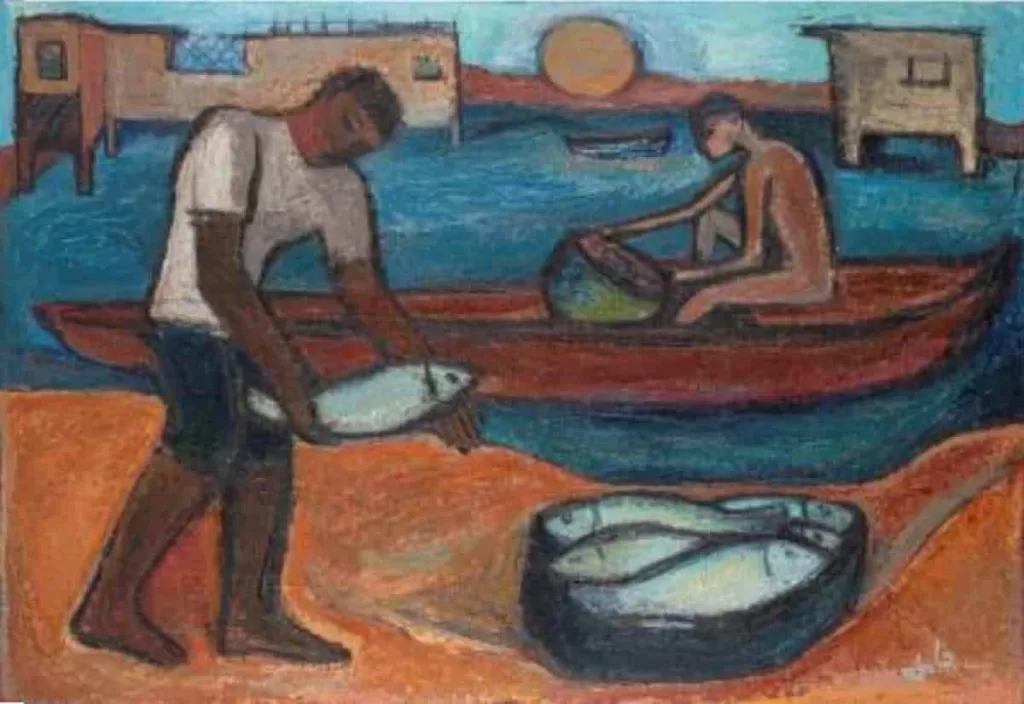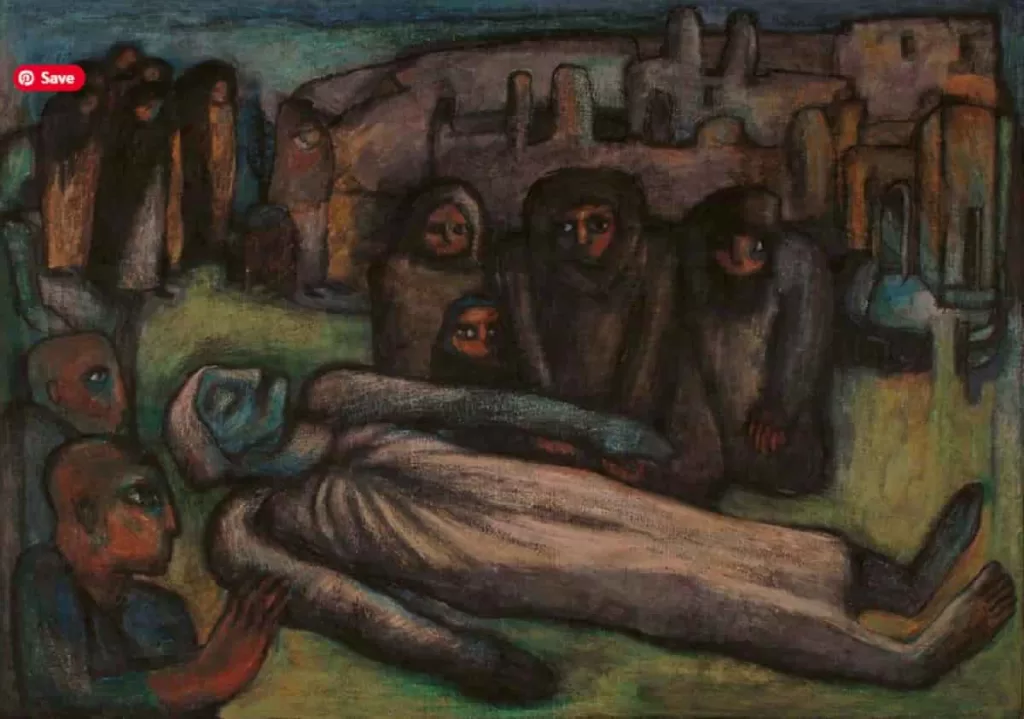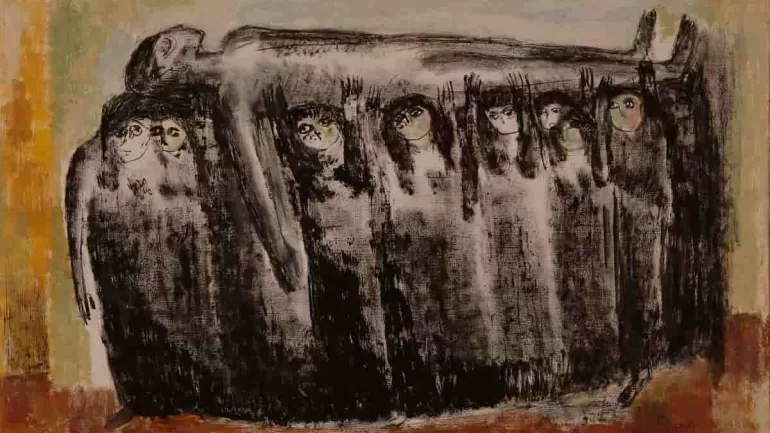ART
Fatma Arargi, The Martyr IV 1968. Oil on Celotex 46×79 cm. Image: Al Masar Gallery
Fatma Arargi exhibition, Man, Place, and Time III, at the Al Masar Gallery celebrates Egyptian art and identity through remarkable works that span decades.
BY KAZEEM ADELEKE, ARTCENTRON
Whenever art historians discuss the evolution of Egyptian art, the name Fatma Arargi inevitably comes up. A pioneering and visionary artist, Arargi used her paintings not only to convey deep emotional resonance but also to capture the spirit of her time. Now, a new exhibition, Man, Place, and Time III, brings her remarkable work back into the spotlight. It showcases why she remains a towering figure in the world of Egyptian art.
At the Al Masar Gallery, this retrospective spans Arargi’s artistic journey from the 1950s to the 1990s. It features powerful pieces that reflect the complexities of human existence and the cultural heart of Luxor. They also highlight the resilience of the working class and the tumult of post-1967 Egypt. With iconic works such as Man & Universe and Walls of Time, the exhibition invites viewers to explore her unique blend of surrealism and social realism—offering a captivating window into the emotions and stories that shaped the modern Egyptian experience.
About Artist Fatma Arargi
Born in 1931 in Cairo, Egypt, Fatma Arargi graduated from the Faculty of Fine Arts in Cairo in 1954. In 1981, after three decades of artistic evolution, she became the head of the painting department at the Faculty of Fine Arts in Alexandria, where she has resided since 1961. Arargi was part of the Third Generation of the Art Movement, dedicated to exploring Egyptian identity in art through a profound interaction with cultural heritage and the political and social dynamics from the 1950s onwards.
Arargi’s artistic journey reflects her commitment to expressing Egyptian identity through various styles of drawing and painting. Her works resonate with the rich tapestry of Egyptian heritage, drawing inspiration from its diverse civilizations. Her Luxor series emerged during her art residency there, showcasing the lives of local fishermen and peasants, which became central themes in her post-war surrealist and abstract works.

Artistic Evolution: Exploring Egyptian Identity
Throughout the 1970s and 1980s, Arargi’s style evolved to metaphysical abstraction, reflecting her deepened philosophical inquiries into the relationship between humanity and the universe. Her earlier works prominently featured everyday life, including motherhood and the experiences of the working class, particularly in rural Egypt. This focus intensified in her later pieces, where she explored the connection between humans and cosmic elements like the earth and sun.
Fatma Arargi’s extensive exhibition history includes solo shows from 1958 to 1989 at prestigious venues such as the Museum of Modern Art, Cairo, and the Mahmoud Said Museum, Alexandria. Additionally, she has participated in numerous solo and group exhibitions in cities such as Rome, Paris, Vienna, and Frankfurt. One of her notable achievements was representing Egypt at the São Paulo Biennial in 1985. Aside from her latest exhibition, she has had several exhibitions at Al Masar Gallery, including in 2019, 2022, and 2023.
Martyr of the Six-Day War
One of Arargi’s fundamental works, Martyr (1967–68), captures the somber emotions following the Six-Day War. This large-scale painting portrays a funeral scene, embodying the grief and turmoil prevalent in the Arab region during that period. The rich colors and emotional depth of the piece reflect Arargi’s ongoing exploration of existence and the human condition.
In the painting, women, men, and children gather around the lifeless body of a man, their expressions filled with grief. Behind them, humble mud houses and other structures loom, grounding the scene in a rural setting. In one corner, several mourners are depicted with their heads bowed in sorrow. The artist masterfully uses body language and color to convey the deep emotional weight of the moment. She captures the raw pain and mourning of friends and family with striking intensity. This powerful use of visual language reflects an extraordinary sensitivity to the mood of loss and the collective experience of grief.

In Martyr IV, the artist explores this dark chapter of Egyptian history. The painting depicts people carrying a corpse to its grave. It is a somber scene, filled with grief. The artist uses black and gray tones, along with dry brush strokes, to capture the mourners’ sorrow as they escort the dead. Their expressions speak volumes about their pain.
But Arargi’s work is not only about suffering. Some of her paintings celebrate life. One example is Hopscotch. This piece shows two young girls playing the classic playground game. One tosses a small object, the “lagger,” onto the ground while the other watches closely. The scene is filled with joy. Flowers surround the children, adding to the cheerful atmosphere. The vibrant red, orange, and red-orange tones contrast with the girls’ gray dresses, amplifying the energy of the moment.
Influences and Reflections
During the 1952 Egyptian revolution, a resurgence of artistic expression emerged as artists sought to document Egypt’s historical layers. Arargi, alongside contemporaries like Effat Naghi and Hamed Nada, delved into local folklore and the complexities of Egyptian identity, harmoniously merging these elements with a contemporary humanist perspective.
Fatma Arargi’s artistic legacy is a testament to her seven-decade journey through the aesthetics of art and life. Her works, characterized by a profound understanding of human existence and cultural heritage, continue to resonate with audiences today. Her contributions to Egyptian art remain a vital part of the cultural conversation.
Fatma Arargi: The Power of Creativity
As we reflect on Arargi’s contributions, her belief that humans strive to explain the universe and their place within it stands out. Her art invites us to consider the deeper connections between people and their environments, reminding us of the enduring power of creativity in shaping cultural narratives.
